
Non-host and insects resistance
The focus of our research group is on breeding for resistance to insects and fungi using molecular genetic approaches. Research comprises all aspects of resistance breeding, including the development of screening tools for the identification of qualitative and quantitative resistance in host or non-host species and potential complications of introgression when related species are used in crosses due to crossing barriers and linkage drag. Additional research steps are the identification, isolation and characterization of genes involved, as well as the determination and use of allelic variation.
Contact: Olga Scholten
Breeding for insect resistant plants
Insects are causing increasing damage to crop production worldwide, most likely due to climate change.
Many crops suffer from insects, either directly through their feeding or indirectly through the transmitted viruses. Until recently, chemical crop protection was regarded as the best way to prevent problems, but due to environmental concerns, other solutions are increasingly preferred. The chemicals used cause damage to beneficial insects, such as predators and parasitoids of the pest insect, pollinators and harmless fauna. In addition, insects develop resistance to the insecticides used very quickly, which calls for higher doses or more toxic compounds.
The use of insect-resistant crops is an attractive way to control insect pests in agriculture (see for example our review published by Broekgaarden et al., 2011). Plants can defend themselves in two ways: 1) directly by killing the insects or disrupting their life cycle, for example by producing trichomes or toxic secondary metabolites, or 2) indirectly by attracting parasitoids or predators that attack the pest insects. In our research group, we mainly focus on the direct defence of insects. To achieve this, we evaluate germplasm for new resistances against sucking insects, mainly aphids, thrips, and whiteflies, and chewing insects such as the Colorado potato beetle and caterpillars.
The development of insect resistant crops can be strongly enhanced by knowledge on plant resistance mechanisms and the genes involved. Resistant material is therefore further characterized with regard to resistance mechanism and inheritance of resistance. The approaches used include genetics, genomics, metabolomics and detailed analysis of life history components of the pest insects.
The research is expected to result in the identification and characterization of insect resistance genes and means of introducing them into crops.
The majority of our projects are carried out in collaboration with breeding companies, the Laboratory of Entomology of Wageningen University, and the business unit Bioscience of Wageningen Research for metabolomics analysis. Most of our projects are funded by the Topsector Horticulture and Starting Materials together with breeding companies, the Ministry of LNV, and the EU.
Contact: Olga Scholten & Lotte Caarls
https://onlinelibrary.wiley.com/doi/full/10.1111/j.1467-7652.2011.00635.x
Tomato
In tomato we study a broad spectrum, trichome based resistance towards small insects, including whiteflies, aphids and thrips. A strong source of resistance was identified in a tomato wild relative originating from the Galapagos islands (Firdaus et al. 2012). This species, Solanum galapagense, produces glandular trichomes that trap small pest insects. Further characterization showed that the production of these specific trichomes is controlled by one major QTL (Vosman et al. 2019). Current work focusses on the further characterization of underlying genes and is part of the EU project Virtigation.
Contact: Lotte Caarls
https://link.springer.com/article/10.1007/s10681-012-0704-2
https://link.springer.com/article/10.1007/s00122-018-3239-7
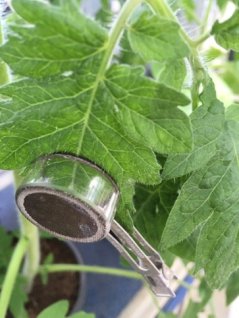
Potato
Potato growers worldwide have to deal with many insect pests. Next to direct damage caused by feeding, insects can also cause indirect damage by transmitting virus and bacterial diseases which can lead to additional yield losses. Combating insects mainly takes place by chemical means, which is undesirable from an environmental perspective (Maharijaya & Vosman, 2015). In our work we focus on aphids, whiteflies and the Colorado potato beetle. Tuber-bearing wild relatives of the cultivated potato have been evaluated for resistance against these three insects and several interesting resistance sources were identified. A selection of these wild relatives is now further characterized with respect to resistance mechanism and genetics of resistance.
Contact: Lotte Caarls
https://link.springer.com/article/10.1007%2Fs10681-015-1467-3
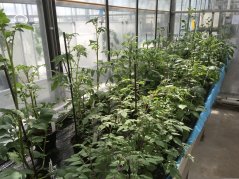
In our group we work on resistance against aphids, whiteflies and thrips, which are the three major pest insects in pepper. Thrips resistance has been identified and characterized. We identified a major QTL underlying the resistance (Maharijaya et al. 2015), that was shown to be effective in several backgrounds (van Haperen et al. 2020). Resistance to the aphid Myzus persicae resistance was found in Capsicum baccatum and showed to affect aphid survival and fecundity (Sun et al 2018). Current research focusses on the introduction of this resistance in C. annuum and on identifying novel resistance sources against another important aphid: Aulacortum solani. Resistance to the whitefly Bemisia tabaci is studied in the project Deltas under pressure, in which we look at the effect of salt stress on whitefly resistance.
Contact: Lotte Caarls & Roeland Voorrips
https://doi.org/10.1007/s00122-015-2558-1
https://doi.org/10.1186/s12870-018-1340-3
https://research.wur.nl/en/projects/deltas-under-pressure-kb-35-001-001
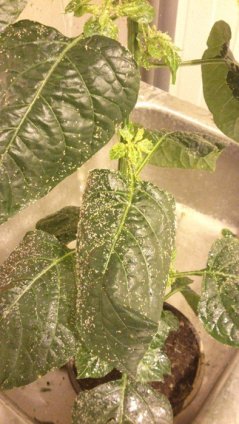
Onions and leek suffer from thrips (Thrips tabaci), resulting in the well-known silvering of the leaves and in transmission of viruses.
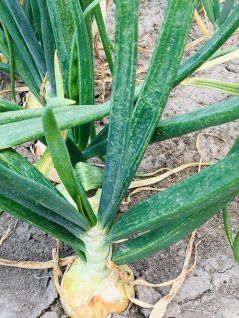
Thrips are causing major losses each year in these Allium crops. Within the green breeding programme.we are carrying out a project on thrips resistance in leek. Good sources of resistance have been identified and research is now. focusing on the introduction into cultivated leek.
https://www.groeneveredeling.nl/nl/groeneveredeling.htm
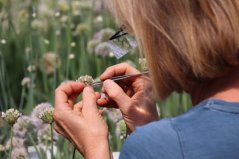
Work in onion has started with the characterization of thrips populations in onion, and the identification of novel sources of resistance. The project aims to provide breeders with the essential tools and materials to introduce thrips resistance in onion. This project strongly benefits from the onion genome sequence that we recently published, and is available from the website of the SEQUON project.
Contact: Olga Scholten
https://www.biorxiv.org/content/10.1101/2021.03.05.434149v1
Chrysanthemum
Chrysanthemums are among the most important ornamental plants and are produced as cut flowers and as potted or garden plant. It is a high value crop, with a low tolerance for damage affecting the visual appearance. Unfortunately, chrysanthemum cultivation suffers from insect pests, of which thrips (Frankliniella occidentalis) are causing the biggest problem.
In the project we aim to characterize the thrips resistance present in cultivated and wild chrysanthemum materials, to identify novel sources of possibly different resistance mechanisms using a genetic approach with segregating populations, elucidating the resistance mechanism and producing easy to use breeding tools.
Contact: Lotte Caarls & Roeland Voorrips
Poinsettia (Euphorbia pulcherrima) is the most important pot plant economically, which is used as decoration especially around Christmas time. In Poinsettia, whiteflies (Bemisia tabaci and Trialeurodes vaporiorum) are causing major problems. There is a zero tolerance in the market for whiteflies or their eggs on Poinsettia. Cultivars only differ in susceptibility, therefore the project focusses on wild relatives of Poinsettia. We aim to identify strong resistance sources and elucidate the genetics of resistance, as well as the mechanism.
Contact: Lotte Caarls en Roeland Voorrips
Cabbage
The cabbage whitefly, Aleyrodes proletella, is a serious pest in Brassica oleracea crops and problems are increasing a.o. due to climate change. Especially kale, Brussels sprouts and savoy cabbage suffer from the cabbage whitefly. Whiteflies cause severe direct damage due to drainage of the phloem and the secretion of honeydew, a sugary and sticky substance on which moulds can grow. Also the presence of the whiteflies themselves and/or the white waxy residue they leave behind detract from the attractiveness of the product. We have identified good sources of resistance against the cabbage whitefly. A number of these were further characterized (Broekgaarden et al. 2012; Vosman et al. 2016).
Contact: Roeland Voorrips
https://link.springer.com/article/10.1007/s10681-014-1306-y?shared-article-renderer
https://doi.org/10.1371/journal.pone.0206103
https://www.cabdirect.org/cabdirect/abstract/20163201705
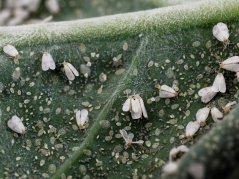
Plants can ‘cry for help’ when attacked by insects through emission of herbivore induced plant volatiles (HIPVs), that can attract parasitoids or predators. These natural enemies can kill the pest on the plant. Until now no attempts have been made to improve the attraction of natural enemies by crop plants through breeding. Using cabbage, we are studying if it is feasible to breed for stronger attraction of natural enemies. Several accessions of (wild) brassica and relatives are compared for attraction of parasitoids and emission of HIPVs after herbivore feeding. Future work will focus on elucidation of the genetics of attraction of natural enemies of pest insects. The project is part of the knowledgebase project Nature Based Solutions.
Contact: Lotte Caarls
https://www.wur.nl/en/Research-Results/Onderzoeksprojecten-LNV/Expertisegebieden/kennisonline/Nature-based-Solutions-for-Climate-Resilient-and-Circular-Food-Systems-1.htm
Breeding for other stresses in lettuce, onion and spinach
Biotic stress resistance in lettuce
A commonplace observation is, that most plant species are completely resistant to almost all potential pathogen species, defined as a nonhost status. This is due to the narrow specialization of most plant pathogens: by far most pathogens have only a limited host range. Recent advances in molecular biology of plant pathogen interactions suggest that adapted pathogens are able to suppress the basal defence of their host plants, but not in, sometimes related, non-host plant species. The basal defense is also known as PAMP triggered immunity (PTI). It is not known which plant genetic factors are responsible for allowing a potential pathogen to succeed (or not) in suppression of this basal defence. For plant breeding it is useful to understand the molecular basis of (non) host status of plants to potential pathogens. When understood, it might be possible to mimic non-host resistance in a host plant species somehow, creating a pseudo-non-host resistance in a host species. Such a resistance would be complete and hard to overcome by the pathogen.
In our group, we have developed a research system to investigate the inheritance underlying (non)host status to biotrophic specialized pathogens: Lettuce/Bremia lactucae.
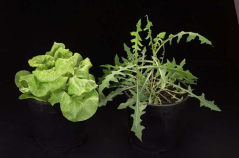
Lettuce cultivation suffers from yield loss by downy mildew (Bremia lactucae). We study the origin and mechanisms of: 1) resistance to downy mildew, and 2) the near-complete reproductive isolation between cultivated lettuce (Lactuca sativa) and a related wild species (L. saligna).
The wild species,L. saligna,is completely resistant to all downy mildew isolates and can be defined as a nonhost species. As a rule, related host and non-host plant speciesare too much diverged from each other and are not crossable or their F1 is completely sterile. Exceptionally,L. salignais crossable withL. sativa and theF1-hybrid is slightly fertile (2% seed set). These interspecificprogenies offera unique opportunity to study the resistance at the genetic level.The final aim is to unravel the genetic network of this complete resistance against downy mildew and to introgress the resistant gene-variantsinlettuce cultivars.
Furthermore, we use the same interspecific cross to study the adverse effects of this interspecific hybridisation. Plant hybrid incompatibilities, like hybrid inviability and sterility, in F1 or derived progenies allow us to elucidate components of evolutionary diversification, speciation and reproductive barriers between these species.
Both phenomena, reproductive isolation and resistance of nonhost species, are genetically complex traits. A good understanding of the causes and consequences of these complex traits is essential for further application in plant breeding.
Contact: Marieke Jeuken
Biotic and abiotic stress resistances in onion
The main topic of our onion research programme is the identification of sources of resistance to pests and diseases in onion-related Allium species and the development of tools for resistance breeding. Onion, Allium cepa L., is an important vegetable crop grown all over the world and suffers from pests such as thrips (see project description above) and fungal diseases as for example Fusarium basal rot caused by Fusarium oxysporum f. sp. cepae and Botrytis leaf blight caused by Botrytis squamosa, as well as downy mildew caused by the Oomycete Peronospora destructor. A. roylei has been identified as a source of resistance to both downy mildew and Botrytis leaf spot, whereas A. fistulosum can be used as a source of resistance to Fusarium basal rot. Problems with Fusarium are increasing rapidly, not only in onion cultivation, but also in other crops. Recently, we have investigated the presence of Fusarium in onion cultivation areas in the Netherlands, and identified onion-pathogenic F. oxysporumin approximately half of the locations where onions were sampled. Also non-pathogenic F. oxysporum isolates were obtained as well as other Fusarium species.
https://pubmed.ncbi.nlm.nih.gov/32748737/
https://www.google.nl/search?hl=nl&q=translate&gws_rd=ssl#spf=1621933116073
https://uireka.nl/wp-content/uploads/2020/12/rapport-2019-04-fusarium.pdf
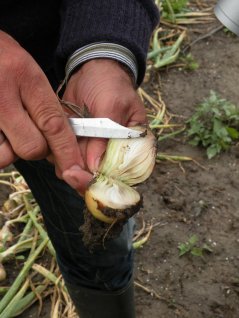
To provide breeders and researchers with genomic tools for research and breeding we sequenced the onion genome that we recently published, and which is available from the website of the SEQUON project. Currently, the genome sequence is being used in a project that is dealing with pre-sprouting problems of onion bulbs. As the induction of sprouting and transition to flowering is highly sensitive to abiotic stresses and physical damage, the annual harvest of the crop requires extreme care in handling procedures. To increase the storability of onions and to prevent the sprouting during storage, plants are treated just before harvest with a chemical agent called MH (maleic hydrazide). The Dutch government intends to cease the application of this chemical compound, if possible by 2030. Designing selection tools to breed for onion bulbs with longer dormancy during storage is therefore a high priority.
https://www.biorxiv.org/content/10.1101/2021.03.05.434149v1
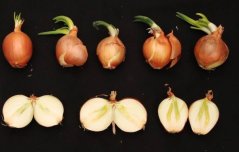
Abiotic stress tolerance to drought is also of high importance for onion, a crop with a shallow root system that lacks root hairs. Genetic differences in root architecture and root length exist among onion cultivars, making it possible to breed for onions with a more extensive and deeper root system. More variation in the root system and in the colonization by mycorrhizal fungican also be obtained by crossing the onion with a related species, A. fistulosum, that is known for its large root system. This implies that there is a lot to gain with respect to drought tolerance by improving the root depth and structure.
Contact: Olga Scholten
https://link.springer.com/article/10.1007%2Fs00122-010-1501-8
Biotic stress resistance in spinach
Non-chemically treated spinach seeds can seriously suffer from damping-off caused by Pythium ultimum. Variation in response to damping-off has been observed between cultivars, but also between seed lots of the same cultivar. Apart from problems with pathogens, breeders also experience that seed vigour plays a role. In this project components of resistance/tolerance and seed vigour are being studied. As pre-emergence damping-off can also be the result of abiotic factors, we started to study the sensitivity of spinach seed germination for high moisture conditions and concluded that germination is driven by oxygen availability and influenced by seed size and pericarp.
Contact: Olga Scholten
PhD thesis for further reading
Magnee, K (2022) From seed to seedling – damping-off tolerance in Spinacia oleracea L.
Steentjes, M. (2021) Peeling the onion. Unravelling the biology of fungal onion pathogens causing leaf blight, neck rot and white rot.
Van Haperen, P. (2020) Towards breeding thrips-resistant varieties in Capsicum.
Sun, M. (2019) The battle between pepper and aphid: genetics and mechanism of host plant resistance.
Giesbers, A. (2018) Nonhost wild lettuce as a donor for resistance to downy mildew in cultivated lettuce
Lucatti, A. (2014) Whitefly resistance in tomato: from accessions to mechanisms.
Chen, X. (2013) Identification of Arabidopsis thaliana genes that can increase resistance towards phloem feeding insects.
Van den Elsen, F. (2013) Resistance Mechanisms against Bemisia tabaci in Wild Relatives of Tomato.
Maharijaya, A. (2013) Resistance to thrips in pepper.
Firdaus, S. (2012) Identification of Whitefly Resistance in tomato and hot pepper.
Galvan, G.A. (2009) Resistance to Fusarium basal rot and response to arbuscular mycorrhizal fungi in Allium.
Broekgaarden, C. (2008) An array of responses to insect feeding in Brassica.
Alvarez, A. (2007) Resistance mechanisms of Solanum species to Myzus persicae.